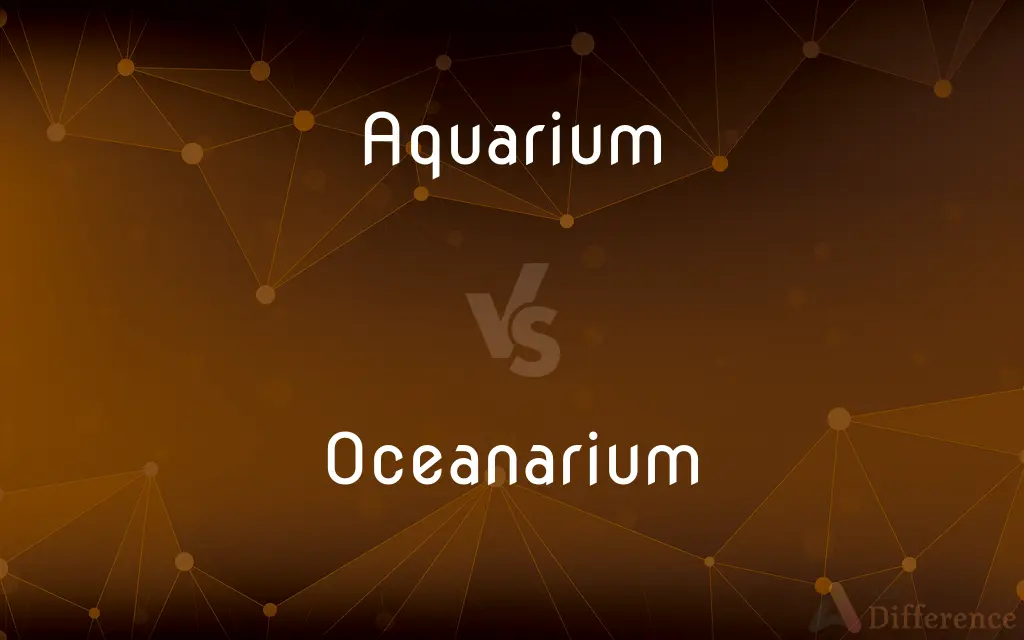Aquarium vs. Oceanarium — What's the Difference?
Edited by Tayyaba Rehman — By Maham Liaqat — Updated on April 26, 2024
Aquariums typically house freshwater and marine species in tanks for observation and study, whereas oceanariums are larger facilities focused on marine life, often featuring large-scale exhibits and shows.

Difference Between Aquarium and Oceanarium
Table of Contents
ADVERTISEMENT
Key Differences
Aquariums are facilities that display aquatic plants and animals in enclosed tanks, providing visitors a close-up view of diverse aquatic life. Whereas oceanariums, a subset of aquariums, emphasize on marine species, particularly large ocean dwellers like whales and sharks.
An aquarium may range in size from small tanks in homes to large public exhibits that simulate various aquatic environments. On the other hand, oceanariums are generally larger-scale facilities that include features such as dolphin shows and whale encounters, aimed at mimicking natural ocean environments.
The primary focus of aquariums is educational, aiming to teach about the biodiversity of aquatic ecosystems through varied displays of species. Conversely, oceanariums often incorporate entertainment aspects, such as sea animal performances and interactive experiences, to engage wider audiences.
Aquariums can be found in many contexts, including research centers, schools, and as part of larger zoological gardens. Oceanariums, however, are usually standalone attractions or part of larger marine-themed parks, focusing on conservation and rehabilitation of marine species.
In terms of conservation, aquariums often participate in breeding programs and educational projects about local freshwater and marine ecosystems. Oceanariums contribute by rehabilitating injured marine animals and advocating for oceanic environmental issues.
ADVERTISEMENT
Comparison Chart
Size & Scale
Varies from small tanks to large exhibits
Generally large facilities with vast tanks
Species Focus
Both freshwater and marine species
Predominantly marine species
Educational Focus
High, with an emphasis on biodiversity
Combines education with entertainment
Typical Features
Tanks, small exhibits, sometimes touch pools
Large tanks, shows, interactive programs
Conservation Role
Breeding programs, local ecosystem education
Marine animal rehabilitation, global advocacy
Compare with Definitions
Aquarium
A public facility where aquatic ecosystems are simulated and displayed.
We visited the aquarium to learn about coral reefs.
Oceanarium
A facility emphasizing the conservation of marine life.
The oceanarium's rescue program helps injured sea turtles recover.
Aquarium
A glass enclosure used to house aquatic plants and animals.
The brightly colored fish swam gracefully in the school's aquarium.
Oceanarium
A marine park with large tanks for oceanic species.
The oceanarium offers a spectacular dolphin show every weekend.
Aquarium
A home for therapeutic and decorative purposes.
Installing an aquarium can create a calming environment in your office.
Oceanarium
An institution involved in marine research.
The oceanarium conducts research on shark behavior and ecology.
Aquarium
A tool for research and education on aquatic life.
Scientists at the aquarium are studying the effects of pollutants on freshwater fish.
Oceanarium
A place to observe marine mammals in near-natural habitats.
Visitors to the oceanarium love the underwater viewing tunnel.
Aquarium
A component of larger zoological institutions.
The city zoo's aquarium section features species from the Amazon River.
Oceanarium
An educational and recreational venue.
School trips to the oceanarium are popular for its interactive learning sessions.
Aquarium
An aquarium (plural: aquariums or aquaria) is a vivarium of any size having at least one transparent side in which aquatic plants or animals are kept and displayed. Fishkeepers use aquaria to keep fish, invertebrates, amphibians, aquatic reptiles, such as turtles, and aquatic plants.
Oceanarium
An oceanarium can be either a marine mammal park, such as Marineland of Canada, or a large-scale aquarium, such as the Lisbon Oceanarium, presenting an ocean habitat with marine animals, especially large ocean dwellers such as sharks.
Aquarium
A tank, bowl, or other water-filled enclosure in which living fish or other aquatic animals and plants are kept.
Oceanarium
A large aquarium for the study or display of marine life.
Aquarium
A place for the public exhibition of live aquatic animals and plants.
Oceanarium
A park where visitors can see marine mammals and/or fish.
Aquarium
A tank, often made of glass, for keeping live fish or other aquatic animals.
Aquarium
A public place where live fish and other aquatic animals are exhibited.
Aquarium
An artificial pond, or a globe or tank (usually with glass sides), in which living specimens of aquatic animals or plants are kept.
Aquarium
A tank or pool or bowl filled with water for keeping live fish and underwater animals
Common Curiosities
Are oceanariums larger than typical aquariums?
Yes, oceanariums are generally larger and house bigger marine species.
What type of educational programs do oceanariums offer?
Oceanariums offer educational programs that include animal shows, interactive sessions, and conservation workshops.
Can you find freshwater species in an oceanarium?
Rarely, as oceanariums primarily focus on marine species.
Do aquariums participate in animal rescue efforts?
Yes, many aquariums are involved in the rescue and rehabilitation of aquatic species.
Can I have an aquarium at home?
Yes, home aquariums can range from simple small tanks to elaborate marine setups.
What is the main purpose of an aquarium?
To display aquatic species in a controlled environment for education and research.
Are there any interactive experiences at oceanariums?
Yes, many oceanariums offer interactive experiences like swimming with dolphins or feeding sessions.
Do aquariums contribute to conservation?
Yes, many aquariums engage in conservation efforts, including breeding endangered species and educating the public about ecosystem preservation.
How do aquariums help in research?
Aquariums facilitate research on aquatic life behaviors, breeding, and environmental impacts.
What kind of animals can you see in an oceanarium?
Oceanariums typically house large marine animals such as sharks, whales, and dolphins.
Is it educational to visit an aquarium?
Absolutely, visiting an aquarium can be highly educational, offering insights into aquatic life and environmental issues.
What are the conservation impacts of oceanariums?
Oceanariums play a significant role in marine conservation, including species rehabilitation and public education on oceanic issues.
What makes oceanariums different from traditional aquariums?
Oceanariums focus more on large marine species and often include elements of entertainment like shows.
Can visiting an oceanarium be considered a recreational activity?
Yes, oceanariums provide recreational activities such as watching marine animal shows and participating in interactive programs.
Are there educational benefits to interactive programs in oceanariums?
Interactive programs in oceanariums enhance learning by engaging visitors directly with marine life and conservation efforts.
Share Your Discovery

Previous Comparison
Horse vs. Sheep
Next Comparison
Sludge vs. SlugAuthor Spotlight
Written by
Maham LiaqatEdited by
Tayyaba RehmanTayyaba Rehman is a distinguished writer, currently serving as a primary contributor to askdifference.com. As a researcher in semantics and etymology, Tayyaba's passion for the complexity of languages and their distinctions has found a perfect home on the platform. Tayyaba delves into the intricacies of language, distinguishing between commonly confused words and phrases, thereby providing clarity for readers worldwide.
















































